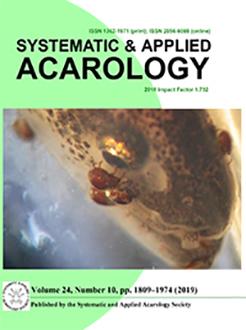Dermacentor variabilis (Say, 1821) is a species of tick native of the Nearctic Eco Zone, through southern Canada, central-eastern United States, and northern Mexico, but there are also populations in western USA, Alaska and Neotropical areas of Mexico (Guzmán-Cornejo et al. 2016, Durden et al. 2016). Adult ticks are parasites of Artiodactyla and Carnivora, with the immature ticks parasitizing mainly rodents and to a lesser extent birds or reptiles (Guglielmone & Robbins 2018). Dermacentor variabilis is also a frequent parasite of humans and has the capacity to transmit diseases as such tularemia, rickettsiosis and can provoked paralysis (Carter et al. 2016, Durden et al. 2016, Guglielmone & Robbins 2018). Furthermore, this species is also vector of anaplasmosis and piroplasmosis, common veterinary diseases (Durden et al. 2016).
Although ticks have low dispersal capacity, they can be translocate to areas outside their natural range of distribution, through migratory birds, pet trade or tourists (Morshed et al. 2005, Goodfellow & Shaw 2005). In this sense, there are reports of D. variabilis exported from the USA to Australia (Halliday & Sutherst 1990), Panama (Bermúdez et al. 2010) and New Zealand (Heath & Hardwick 2011). Exportation seems to be highest risk in June to July, the time when the most tick activity is seen in North America (Burg 2001).
In this paper, we report the second finding of a D. variabilis in Panama. A 64-year-old male infectious diseases physician traveled from Milwaukee, Wisconsin, USA, to Panama, after giving a lecture on tropical medicine. The affected and his wife visited Milwaukee in May of 2019 and walked through several prairies in the peri-urban areas of the city. During these walks, both noticed several males and females D. variabilis crawling on their clothes and skin, although did not notice bites. Several days later in Panama, the man observed a tick on his neck. The tick was transported to the Department of Medical Entomology of the Gorgas Memorial Institute (ICGES) in Panama and morphologically identified (Briton et al. 1965, Yunker et al. 1986). The tick was examined using a stereomicroscope Leica M 205A and photographed with a camera Leica MC 170 HD. At the time of identification, it could be observed that tissue was maintained in the hypostome, which could indicate that the tick adhered and then detached. The specimen has been deposited in the Zoological Collection "Dr. Eustorgio Méndez "in ICGES (Fig. 1, 2).
The role of exotic ticks in public health is unclear. Even so, there is a potential risk to the traveler (Chen & Wilson 2009, Ramharter et al. 2010). Considering that a tourist could become infected during the last days of the trip, the symptoms would appear on return to the country where medical personnel may be unfamiliar with foreign vector borne diseases. This could complicate the diagnosis of the disease and delay treatment, especially if the history of the tick bite is not reported. For example, D. variabilis is a vector of Rickettsia rickettsii and Francisella tularensis; while R. rickettsii is considered an important pathogen in Panama (Bermúdez et al. 2018), there are no records of tularemia in this country. Moreover, because the species could be confused with native ixodid fauna, the correct identification of the tick species is also important to determine so such exotic diseases can be considered in tourists and pets (Halliday & Sutherst 1990, Bermúdez et al. 2010, Heath & Hardwick 2011).







